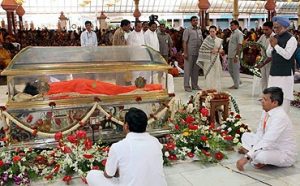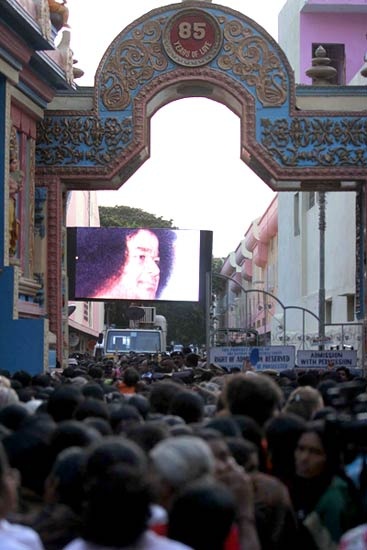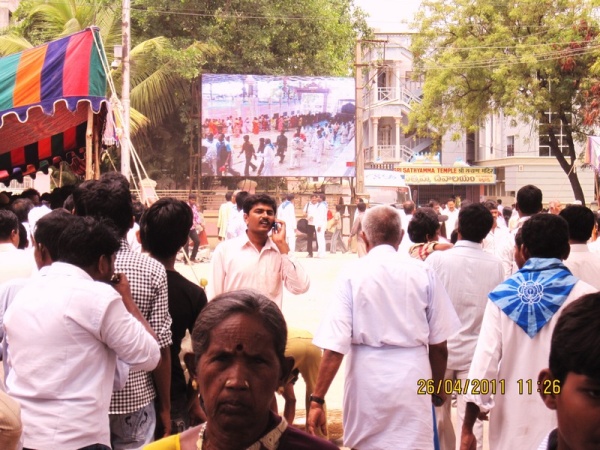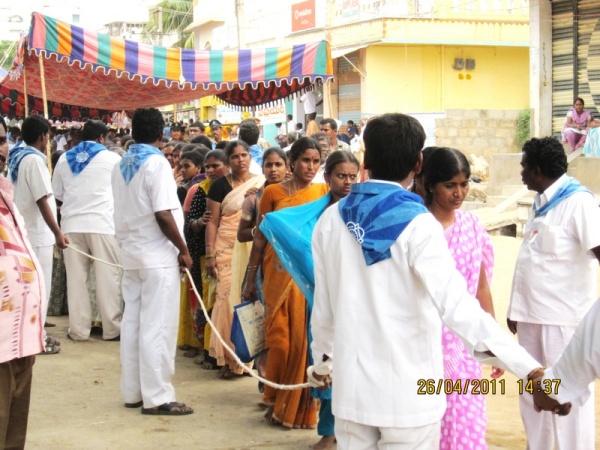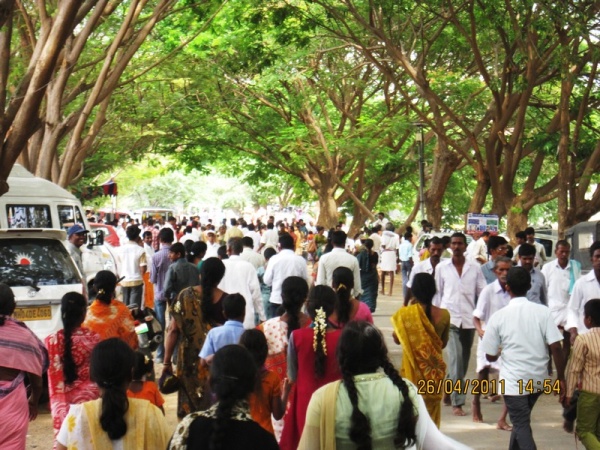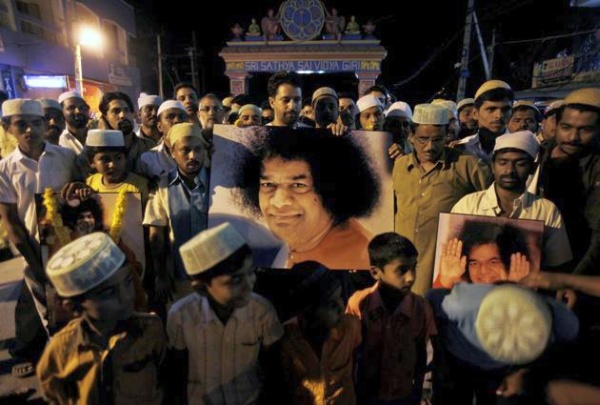During bhajans on Sunday morning a sense of continuity was garnered whilst singing bhajans … during Rama Hare Sai Krishna Hare I felt continuity between then (yesteryear) singing bhajans in the darshan hall, and now – singing bhajans in the darshan hall – as if nothing had really changed and this bliss began to emerge from within and well up to the point where I just about couldn’t sing. The same feeling came during singing of Guru Brahma, Guru Vishnu, Guru Devo Maheshwara. The primary school children and the women were really leading the singing, their voices rose over the top of all others … even when the power went off, it was the children and the ladies you could hear singing. The men went, well, kinda soft voiced … but the loss of power didn’t stop the young ones, they just went on louder and stronger.
Actually, something did happen today, I had forgotten it until just now. I was sitting there, taking padnamaskar on the inner level and establishing that inner connection with Swami towards the end of vedam, simply focusing on Swami’s feet – which I could see clearly – and I was trying to continue that and make it last a bit longer. So focussing on Swami’s feet, see my hands on Swami’s feet. Do this for some time, until I felt this flutter and a bird’s wing touch the top of my head whilst I was happily concentrating on Charana Kamala, the Lotus Feet … and I thought to myself, well, talk about “On a wing and a prayer!” I briefly wondered what that was all about but I didn’t have much chance to think for long, as the OM’s for bhajans began.
Samasta Loka Sukhino Bhavantu was being sung, and once again, bliss began to well up in me, like a wave crashing on the shores of the ocean; a wave of joy, joy, joy … actually rising from somewhere within and wafting through me. You know that smile and that joy that just comes … and stays.
I took lunch (and just about the rest of the day) with friends, and I noted that we were all writers and authors, not unlike that group of authors in The Inklings of Oxford, which Tolkien had written about. We numbered a former diplomat turned writer, a newspaper editor, a television and stage personality who is currently writing her memoirs, and this blogger who has written over the years.
I passed some comments on Chinna Katha Volume I and II, and recalled some examples of Swami as a master story teller, nay, the greatest story teller. In one or two sentences, Swami would set a scene, a background, establish a character and begin to drive the plot of the story forward. I used to fall into Swami’s stories; he is peerless as a story-teller.
The conversation turned to stories of our different experiences of the last days of Swami in the form and the events of the days leading up to Swami’s entombment in the darshan hall. (All of my companions this afternoon are long term residents of Prashanti Nilayam.) Each had a different tale to tell.
Our former diplomat turned writer spoke first of the assignment of thousands of police in Puttaparthi township and closing the roads off and banning all vehicular traffic in Puttaparthi and around the ashram itself. The impact of this underscored the serious turn of events during Swami’s stay in hospital. He spoke of a shamina (tent) erected along the side of Gopuram Road all the way down to the Old Temple Complex, and the human river which filled every street in Puttaparthi. He recalled the demeanour of the crowds – the people in these queues were so well behaved; there was no pushing or jockeying for position, but rather, a singularity of purpose, a common recognition of why they were there and a shared responsibility and compassion for others in the queue, a bonding of love. And the seva of the Puttaparthi villagers along with those members of the Puttaparthy Samithi (Sai Group) toward these people in the queues, how they went along with water and provisions for these devotees of the Lord. The external television screens erected and connected up in many places in Puttaparthi township.
Our newspaper editor told that Swami’s form was always a bother to him, and sort of “got in the way” for him. Swami for him was always the omnipresent principle, the one who is omniscient, omnipotent, and everywhere. He quoted from “Awaken” and “Your Mission has begun” where death and the afterlife are not to be feared, for the most marvellous experiences await us after this vale of tears and sorrow. He spoke of watching events unfold from afar, of being asked to do seva with editing material as events drifted towards their inevitable conclusion, of working with people in media in Prashanti Nilayam who were toiling with incredible anxiety and struggling under untold pressure to get a message out to the world, day by day. (Sathya Sai Baba is thought to have 100 million devotees, perhaps more.) The external pressure on those in the publishing division exceeded any pressure he had experienced in all his years working in the newspaper environment.
Our television personality – Thespian narrated how she was guided by the inner voice to take a holiday away from Prashanti before all this unfolded; of how she returned unknowingly into a sea of anxiety and drama as Swami’s days drew to a close. She spoke of media reports and the television coverage on IBN, holed up, watching all of this unfold. How she went out into Gopuram Road and a television crew bailed her up with a microphone in her face, asking, “And how do you feel now that Sai Baba has died?” She looked at the reporter with incredulity, and how she said to them, “Sai Baba is not dead, he’s just left his body”. Of being in the queue, up close nearby the gopuram, and the women around her, their neediness in this moment, and how the shared sisterhood of love surrounded them and of giving succour to those most in need. Then she felt, “I don’t really need to be in this queue, what am I here for?” And went back home.
Your correspondent and narrator shared the unfolding of these events overseas, of dribs and drabs of newspaper reports of Swami in hospital, and the paucity of news coverage from the official channels in those early days. It was almost like a communications blackout until Dr Safia began giving his daily reports. Dr Safia’s video interviews gave much needed news and comprehension of why Swami was in hospital, and how GV – Venkataraman did his interviews, and how we came to learn of the medical issues concerning Swami’s operations and why his bodily condition was like so; of how Sri Indulal Shah organised a worldwide bouquet of prayers and vigils for Swami’s well-being; and the critical importance of the daily news bulletins given out from the Super Specialty Hospital. And then the media reports of mobs at the hospital, the roughing up of the Collector’s car and damage, and photographs of hundreds of police in Puttaparthi Township. Conflicting media reports, and speculations. Then the final news, brief, shocking; of hunting around on the internet for validation and confirmation, which came all too true. It had happened. The struggle, scrapping and search for information and keep devotees up to date with confirmed news, with information and programs that had some auspice or provenance, and of celebrations of the life of Swami back home.
I shared bewilderment at Swami’s apparent departure from the form almost “ten years early”; what did this mean, why was it so? I was paralysed with grief, unable to function until the inner voice pierced through all that with I have not gone anywhere! … Of reading explanations about lunar years versus the solar calendars; sheer disgust at the newspapers for speculating on the succession, mentioning Ratnakar and Satyajit as successors, totally ignoring the tri-avatara. Madness, it was. How could they speculate so? The continuing repugnance with people and media who say “Sai Baba died!”.
And then the rumours, money, cars and trucks stopped at night and searched, failure of just about every media source to explain guru-dakshina and how Swami was detached from wealth, dhana, and all the money that was given to him in letters. Misuse of money rumours and the media in India. They soared to unbelievable heights with their theories and speculations.
It was instructive to listen to three professionals in media and communications discuss the newspaper coverage and other coverage (or lack thereof) leading up to Swami’s interment, and the field day the media pack had with rumours about the room filled with money, gold and precious gems. How the Central Trust and the worldwide Sai Organisation stumbled their way through the early days of this saga, only to kick into overdrive, and do the task they had never expected to have to do. They spoke of the distress and vehement defence of Swami and the ashram trust by the Puttaparthi villagers later on outside the media conferences, how a dharna was staged against the media for their mistrustful reporting and interviewing people who really knew nothing, just devotees walking along the street and broadcasting their words for gospel truth. Oh, the horror, they said.
Four different storytellers, all professionals as communicators in their own field; one opens the petals of the lotus and provides all the background and nuances of a tale, and provides depth of understanding in the telling. Another who has professional tradecraft of myth, legend, art, symbol, metaphor, how words are suffused with meaning yet can be supplanted by drama, expression, tapping into the universal archetypes of humanity and art. Another who communicates through voice, facial expression, laughter, joy, and body language behind the camera and on the stage. Finally, your narrator who is often mindful of T.S. Eliot and his poem wherein he depicts those who have the experience and miss the meaning. I prefer to take the word understanding and reverse it, to “stand under” the experience and allow it to shed its light upon you.
A churning it was, we concluded, akin to the churning of the ocean where the halahala poison had to come out in order that the sacred nectar called amrit might be retrieved and consumed. Yet, the story of Swami’s passing, as each storyteller gives it, is only one facet of the divine diamond that makes up all of this reality, this maya, which is really an immersion in the sea of God; it is his drama, his play – so clearly illustrated – as one storyteller shared, Swami manifested before one lady in Puttaparthi township during all this drama – before the interment – and said to her, I am still in charge!
There are many other tellings of the passing of Sathya Sai from Sai with form to Sai the formless who encompasses all this, and more. It is a telling that must be told, yet, remain untold as we give the telling in the daily moments of the lives of His devotees, wherein his love resides and goes forth as selfless love, selfless service, devotion and integrity – and is witnessed by all the worlds.
From the Narrative:
Scenes from Puttaparthi, 26 April 2011
Yesterday, there were crowds, crowds, crowds in Prashanthi Nilayam
Gives you an idea of the crowds in Prashanti Nilayam yesterday
The Sri Sathya Sai Trust is obviously well prepared. Marquees run all the way around the town to protect devotees from the summer sun. Huge television screens at strategic points carried views of Kulwant Hall and Swami’s Perspex casket.
Volunteers handed out plastic sachets of water and there were also several food stations along the way. Police, contrary to their lathi-bearing image, were solicitous and gentle. All along the route, at traffic circles and under pavement trees, abandoned shoes and sandals lay in heaps where they had been abandoned by devotees anxious not to miss their final darshan.
Police and seva dals guided thousands of men women and children throughout the day. There were two queues, one each for men and women, but all led along the main road to the Ganesha Gate of Prasanthi Nilayam.
There were similar crowds throughout and around the entire town.
Motor vehicles are not being allowed into the town, so people had to walk the last two or three kilometres to the ashram.
Last night, the Muslims of Puttaparthi honoured Sri Sathya Sai Baba
Prime Minister takes final darshan of Sathya Sai Baba

© Chris Parnell
![]()

